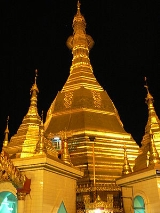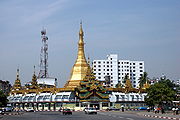
Sule Pagoda
Encyclopedia
The Sule Pagoda is a Burmese stupa
located in the heart of downtown Yangon
, occupying the centre of the city and an important space in contemporary Burmese politics, ideology and geography. According to legend, it was built before the Shwe Dagon pagoda during the time of the Buddha
, making it more than 2,500 years old. Burmese legend states that the site for the Shwe Dagon pagoda was asked to be revealed from an old nat
who resided at the place where the Sule Pagoda now stands.
The Sule Pagoda has been the focal point of both Yangon and Burmese politics. It has served as a rallying point in both the 1988 uprisings
and 2007 Saffron Revolution.
The pagoda is listed on the Yangon City Heritage List
.
that the Buddha himself is said to have given to the two Burmese merchant brothers, Tapissa and Balika. The dome structure, topped with a golden spire, extends into the skyline, marking the cityscape.
(spirit) named Sularata (the Sule Nat). The king of the Nats, Sakka, wished to help the legendary king Okkalap build a shrine for the Buddha's sacred hair-relic on the same site where three previous Buddhas had buried sacred relics in past ages. Unfortunately, these events had happened so long ago that not even Sakra knew exactly where the relics were buried. The Sule nat, however, who was so old that his eyelids had to be propped up with trees in order for him to stay awake, had witnessed the great event. The gods, Nats and humans of the court of Okkalapa therefore gathered around the Sule Ogre and asked him the location, which he eventually remembered.
The Sule Pagoda was made the center of Yangon by Lt. Alexander Fraser of the Bengal Engineers, who created the present street layout of Yangon soon after the British occupation in the middle of the 19th century. (Lt. Fraser also lent his name to Fraser Street, now Anawrattha Street and still one of the main thoroughfares of Yangon). It is a Mon-style chedi
(pagoda), octagonal in shape, with each side 24 feet long; its height is 144 feet, 9 l/2 inches. Except for the chedi itself, enlarged to its present size by Queen Shin Sawbu
(1453–1472), nothing at the pagoda is more than a little over a century old. Around the chedi are ten bronze bells of various sizes and ages with inscriptions recording their donors' names and the dates of their dedication. Various explanations have been put forward for the name, of varying degrees of trustworthiness: according to legend it was called su-way, meaning "gather around", when Okkapala and the divine beings inquired about the location of Singattura Hill, and the pagoda was then built to commemorate the event; another legend connects it su-le, meaning wild brambles, with which it was supposedly overgrown, and a non-legendary suggestion links it to the Pali words cula, meaning "small" and ceti, "pagoda".

, the pagoda was an organizing point and destination selected on the basis of its location and symbolic meaning. In 2007, during the Saffron Revolution, the Sule Pagoda was again utilized as a rallying point for the pro-democracy demonstrations. Many thousands of monks gathered to pray around the pagoda. Sadly, in both 1988 and 2007, the Sule Pagoda became the first place to witness the brutal reaction by the Burmese government against the protesters.
Stupa
A stupa is a mound-like structure containing Buddhist relics, typically the remains of Buddha, used by Buddhists as a place of worship....
located in the heart of downtown Yangon
Yangon
Yangon is a former capital of Burma and the capital of Yangon Region . Although the military government has officially relocated the capital to Naypyidaw since March 2006, Yangon, with a population of over four million, continues to be the country's largest city and the most important commercial...
, occupying the centre of the city and an important space in contemporary Burmese politics, ideology and geography. According to legend, it was built before the Shwe Dagon pagoda during the time of the Buddha
Buddha
In Buddhism, buddhahood is the state of perfect enlightenment attained by a buddha .In Buddhism, the term buddha usually refers to one who has become enlightened...
, making it more than 2,500 years old. Burmese legend states that the site for the Shwe Dagon pagoda was asked to be revealed from an old nat
Nat (spirit)
The nats are spirits worshipped in Burma in conjunction with Buddhism. They are divided between the 37 Great Nats and all the rest . Almost all of the 37 Great Nats were human beings who met violent deaths . They may thus also be called nat sein...
who resided at the place where the Sule Pagoda now stands.
The Sule Pagoda has been the focal point of both Yangon and Burmese politics. It has served as a rallying point in both the 1988 uprisings
8888 Uprising
The 8888 Nationwide Popular Pro-Democracy Protests was a series of marches, demonstrations, protests, and riots in the Socialist Republic of the Union of Burma...
and 2007 Saffron Revolution.
The pagoda is listed on the Yangon City Heritage List
Yangon City Heritage List
The Yangon City Heritage List is a list of man-made landmarks in Yangon, Myanmar, so designated by the city government, Yangon City Development Committee. The list consists of 188 structures , and is largely made up of mostly religious structures and British colonial era buildings. The list is...
.
Stupa
The Sule Pagoda incorporated the original Indian structure of the stupa, which initially was used to replicate the form and function of a relic mound. However, as Burmese culture became more independent of its South Indian influences, local architectural forms began to change the shape of the pagoda. It is believe to enshrine a hair of the BuddhaBuddha
In Buddhism, buddhahood is the state of perfect enlightenment attained by a buddha .In Buddhism, the term buddha usually refers to one who has become enlightened...
that the Buddha himself is said to have given to the two Burmese merchant brothers, Tapissa and Balika. The dome structure, topped with a golden spire, extends into the skyline, marking the cityscape.
History and legend
According to Burmese legend the site where the Sule pagoda now stands was once the home of a powerful natNat (spirit)
The nats are spirits worshipped in Burma in conjunction with Buddhism. They are divided between the 37 Great Nats and all the rest . Almost all of the 37 Great Nats were human beings who met violent deaths . They may thus also be called nat sein...
(spirit) named Sularata (the Sule Nat). The king of the Nats, Sakka, wished to help the legendary king Okkalap build a shrine for the Buddha's sacred hair-relic on the same site where three previous Buddhas had buried sacred relics in past ages. Unfortunately, these events had happened so long ago that not even Sakra knew exactly where the relics were buried. The Sule nat, however, who was so old that his eyelids had to be propped up with trees in order for him to stay awake, had witnessed the great event. The gods, Nats and humans of the court of Okkalapa therefore gathered around the Sule Ogre and asked him the location, which he eventually remembered.
The Sule Pagoda was made the center of Yangon by Lt. Alexander Fraser of the Bengal Engineers, who created the present street layout of Yangon soon after the British occupation in the middle of the 19th century. (Lt. Fraser also lent his name to Fraser Street, now Anawrattha Street and still one of the main thoroughfares of Yangon). It is a Mon-style chedi
Stupa
A stupa is a mound-like structure containing Buddhist relics, typically the remains of Buddha, used by Buddhists as a place of worship....
(pagoda), octagonal in shape, with each side 24 feet long; its height is 144 feet, 9 l/2 inches. Except for the chedi itself, enlarged to its present size by Queen Shin Sawbu
Shin Sawbu
Shin Sawbu was the queen of Hanthawaddy from 1453 to 1472. Queen Shin Sawbu was also known as Binnya Thau or Old Queen in Mon. Queen Shin Sawbu and Queen Jamadevi of Haripunjaya are the two most famous queens among the small number of queens who ruled in mainland Southeast Asia...
(1453–1472), nothing at the pagoda is more than a little over a century old. Around the chedi are ten bronze bells of various sizes and ages with inscriptions recording their donors' names and the dates of their dedication. Various explanations have been put forward for the name, of varying degrees of trustworthiness: according to legend it was called su-way, meaning "gather around", when Okkapala and the divine beings inquired about the location of Singattura Hill, and the pagoda was then built to commemorate the event; another legend connects it su-le, meaning wild brambles, with which it was supposedly overgrown, and a non-legendary suggestion links it to the Pali words cula, meaning "small" and ceti, "pagoda".

Location
The Sule Pagoda is located in the center of downtown Yangon and is part of the city’s economic and public life. During the 1988 and 2007 protests, the Sule Pagoda was a functional meeting point for anti-government and pro-democracy protesters.Role in Burmese politics
During the 8888 Uprising8888 Uprising
The 8888 Nationwide Popular Pro-Democracy Protests was a series of marches, demonstrations, protests, and riots in the Socialist Republic of the Union of Burma...
, the pagoda was an organizing point and destination selected on the basis of its location and symbolic meaning. In 2007, during the Saffron Revolution, the Sule Pagoda was again utilized as a rallying point for the pro-democracy demonstrations. Many thousands of monks gathered to pray around the pagoda. Sadly, in both 1988 and 2007, the Sule Pagoda became the first place to witness the brutal reaction by the Burmese government against the protesters.

